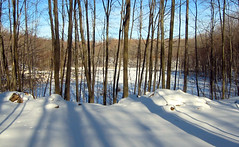Eco: Ice water in their veins
News that bacteria frozen in Alaskan ice for 32,000 years began to stir as soon as it was thawed created a stir among scientists from microbiologists to cosmologists recently.

The discovery of the new species, Carnobacterium Pleistocenium, in a brownish patch of ice dating from the days of Wooly Mammoths and Saber-toothed tigers, led to speculation that some microbes might be able to slowly metabolize locally available nutrients and maintain the viability of their DNA under extreme conditions.
“It greatly enhances the possibility that there may be life existing on Mars today,” NASA scientist Richard Hoover, who discovered the microbe in 2000, told CNN. “Unicellular bacteria might have remained alive, frozen in the Martian sea.”
Whether Hoover is on the right track, or his find was tainted by a modern contaminant, as some suspect, there are many other remarkable examples of life’s ability to adapt to cold environments that can be found on the earth today.
Here in Connecticut, we have several amphibians and reptiles with cold weather adaptations of their own. According to Dr. Ken Storey, of Carleton University, several "freeze tolerant vertebrates" are native.

Two of the first frogs to emerge following cold snowy winters like this year’s are the Wood Frog and Spring Peeper. Both are able to tolerate some freezing, but the Wood Frog is the amphibian Ice King.
“Frozen [Wood] Frogs have no heart beat, no blood circulation, no breathing, no detectable brain activity and cannot move yet miraculously all vital functions return within 1-2 hours when frogs thaw.” writes Storey. He says that as much as 65% of the Wood Frog’s total body water may be converted to ice, and they can survive days or weeks of freezing.
Grey Tree Frogs, which have the ability to change color while active, turn blue when frozen.
Painted Turtles are among local reptiles able to survive a freeze. Young turtles hatch in fall and have to be freeze tolerant to survive their first winter. Adults are able to survive several months under pond ice without breathing oxygen. Among other freeze tolerant reptiles Storey lists Box Turtles and Garter Snakes, able to survive a day or so outside burrows or dens at sub-freezing temperatures.
Whether there turns out to be life frozen in Martian seas or not, there are likely a number of species lying frozen under the snow and ice in Connecticut, waiting practically motionless for the spring thaw.
0 Comments:
Post a Comment
<< Home